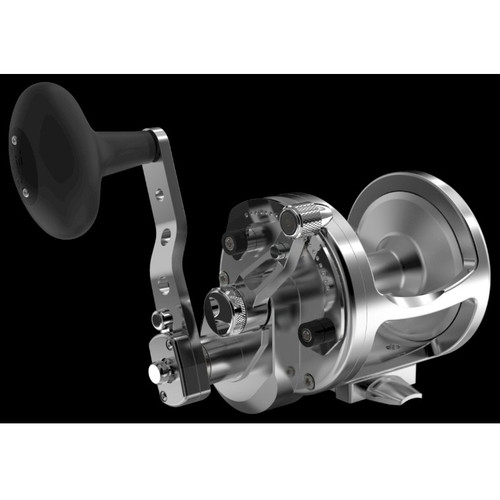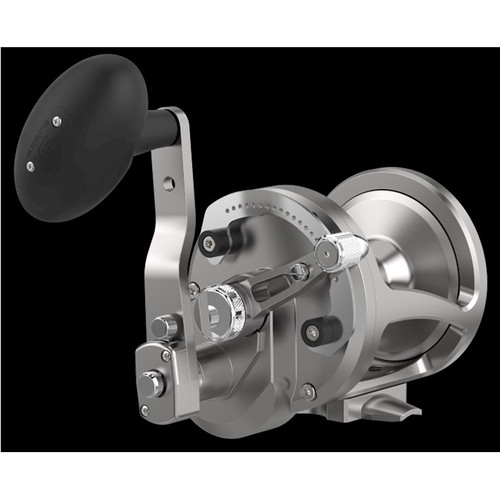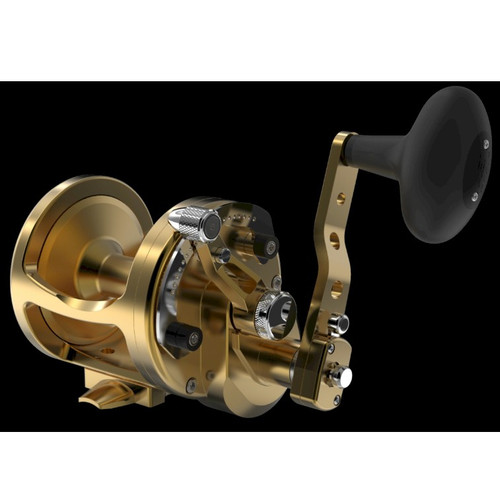Product Description
LX 6/3 MC RAPTOR Classic Two Speeds
- Patented M.C. Cast Control System.
- Features Our Patented, Powerful Dual Carbon Fiber Drag System.
- Precision Machined 6061 T-6 Marine Grade Aluminum And Stainless Steel Components.
- Anodized For Superior Corrosion Resistance And Beautiful Finish.
- Re-Designed, True One Piece Frame For The Ultimate In Strength Vs. Weight.
- Powerful Lever Drag System With Adjustable Strike Pre-Set.
- Ratcheting Glide Plate, And Strike Stop Button (Optional )
- Precision Machined Stainless Steel Gears.
- Our Patented, Indestructible, SILENT Dog And Gear Anti-Reverse System, The Most Reliable In The Industry, Re-Designed With More Engagement Teeth To Reduce Handle Back-Play.
- Reliable Avedrag Dry Carbon Fiber Drags For Superior Stopping Power, Smoothness, And Wear Resistance.
- Re-Designed, Loud Alarm Clicker
- Offset Machined Handle Arm To Reduce Centerline Profile And Cranking Wobble.
- Large Comfortable Soft Touch Handle Knob.
- Raptor Series: 9 Related Stainless Steel Ball Bearings.

What Are The Advantages Of A Lever Drag?
There Are Many Advantages To A Lever Drag Reel Over A Typical Star Drag Type Reel. First And Foremost, Are The “Strike Pre-Set” And The Ability To Always Go Back To The Exact Original Drag Setting, No Matter Where You Have Increased Or Decreased The Drag With The Lever During A Fight With A Fish. Lever Drags Are Simple To Use, With One Lever Control That Puts The Reel Into Free-Spool, Increases Or Decreases Drag Pressure, And Instantly Locates Your Original Drag Setting By Sliding The Lever To The Strike Position. Lever Drag Reels Are Typically Simpler In Design And Contain Fewer Small Parts, And Are Easier To Maintain. Also, Because The Drag System Works In Direct Contact With The Spool, Rather Than Through The Gear Train Like A Star Drag, The Drag Is Smoother And More Consistent, Allows More Surface Area For The Brake Discs, Dissipates Heat More Efficiently, And Doesn’t Have To Go Through Gearing With Load And Wear On Gear Teeth To Operate. Another Distinct Advantage Of An Avet Lever Drag Reel Is The Drag Will Never Wear Out. It Is A Given Routine That Star Drag Washers Need To Be Replaced Regularly, Because They Wear Out. This Is Because With A Star Drag Reel, The Drag Washers Are Housed Inside The Main Drive Gear Of The Reel. This Means That From The Spool, The Drag Has To Go Through A Gear Reduction Before The Drag Washers Turn. If You Compare A Similar Star Drag Reel And A Lever Drag Reel, Both Having A 6:1 Gear Ratio, The Star Drag Reel Will Require Six Times The Amount Of Pressure On The Drag Washers As The Lever Drag Reel Does To Achieve The Same Amount Of Drag Pull At The Line. Because The Lever Drag Reel Has Six Times Less Pressure On The Drag Surface Itself, This Means Less Wear, Less Heat, And Far Less Maintenance.
How Do I Use A Lever Drag?
The Overall “Motion” And Control Function Is Simple, And Somewhat Similar To Any Bait Casting Reel. With Most Baitcasters, You Flip A Tiny Lever Or Switch To Engage The Reel From Free Spool. A Lever Drag Is Similar, Only You Use The Lever, Sliding It From Free Spool To The Strike Position. Instead Of Using A Star Knob To Adjust Drag Tension While Fighting A Fish, You Simply Move The Same Lever Forward Or Back To Increase And Decrease Drag. You Can Move The Lever Back And Forth All You Want, And Still Get Back To The Original Drag Setting By Placing The Lever In The Strike Position. A Star Drag Is Nearly Impossible To Find The Original Drag Setting Once It Has Been Moved. The Strike Preset Feature Of An Avet Lever Drag Eliminates Any Guessing.
What Is The MC Cast And How Does It Work?
The M.C. Cast, Or “Magic Cast”, Is An Adjustable Magnetic Anti-Backlash Cast Control System Using Lenz’s Law To Prevent Line Overrun And “Birds’ Nests” While Casting. When Casting A Lure, Its Velocity Through The Air (And Pull On The Line Coming From The Spool) Is Gradually Slowed Due To Wind Resistance, And Altitude Drop After Reaching Its Apex In Flight. Although The Lure Slows Down, The Reel Spool Continues To Spin At The Same Velocity As The Lure Before It Slowed Down, Resulting In A Line Overrun Or Backlash. Unlike Most Baitcasting Reels That Apply Resistance To The Spool To “Tame” The Free Spin By Applying Mechanical Friction, The MC Cast System Makes No Contact With The Spool At All. It Works Using A Powerful Magnet Mounted In The Frame Pointing At The Aluminum Side Of The Spool. Although Aluminum Is Not Magnetic, When It Spins, It Creates Its Own Magnetic Field. The Magnet Interrupts This Magnetic Field Generated By The Spinning Spool, Creating And Eddy Current And A Slight Braking Effect. The Power Of The Braking Effect Is Directly Proportionate To The Speed That The Spool Is Spinning, The Faster The Spin, The More Powerful The Braking. More Importantly, The Slower The Spin, The Less Braking, And No Spin At All Means No Braking. This Is A Benefit That Mechanical Friction Cast Controls Do Not Have. Because The Braking Effect Is Proportionate To The Speed Of The Spool, And The MC Cast System Makes Absolutely No Friction Contact With The Spool, The Start-Up Inertia To Get The Spool Moving While Casting Is Completely Unaffected, And Has No Braking Or Friction To Overcome To Get The Spool Moving. This Is Critical For Casting Efficiency, Especially When Casting Very Small Or Light Baits. This Is Also Beneficial When Letting A Small Bait Swim And Pull Line, Or Even Simply Dropping A Light Weight To The Bottom With No Spool Resistance.
The Size And Power Of The Magnet Is Calibrated In Proportion To The Mass Of The Spool Of Each Model With Line Installed, To Provide The Exact Same Resistance As Your Thumb Would Normally Apply To The Spool While Casting. The Power Of The Magnet Is Adjustable To Accommodate Different Casting Weights And Wind Conditions Using Avets’ Patented Polar Amplification Technology. Adjusted Correctly, You Will Not Have To Thumb The Spinning Spool While The Lure Is Flying Through The Air. The M.C. Cast Option (Standard On Raptors) Will Have You Casting Like A Pro, Even If You Have Never Cast A Conventional Baitcasting Style Reel.
How Do I Use The M.C. Cast Control?
The M.C. Cast Is The Most Reliable And Consistent Cast Control Available, Making The Avet M.C. Reels The Easiest Reels To Cast, Even If You Have Never Cast A Conventional Style Reel.
Start With The M.C. Cast Control Adjustment Knob Turned To The Maximum Setting, 5. While Casting, Hold The Spool With Your Thumb, Cast, And Let It Fly! While The Lure Is Flying Through The Air, Don’t Thumb The Spinning Spool, Let The Magnet Do Its Work. Just Before The Lure Hits The Water, Stop The Spool With Your Thumb. Repeat, And Gradually Reduce The Adjustment Setting With Each Cast. Once You See Loose Line Forming On The Spool While It’s Spinning, Increase The Setting By One Number. Casting Lighter Weights Will Require Higher Settings, And Heavier Weights Will Use Lower Settings. You Will Quickly Develop A “Feel” For Which Settings Work Best For Your Style Of Casting, The Type Of Rod You Are Using, Different Weights, And Casting Into Headwinds.
Are Avets Made Entirely In The USA?
Yes. Avet Reels Are All Designed, Machined And Assembled In Our Factory In Chatsworth California. Every Part Including All Internals Are Made In House With The Exception Of The Bearings Which Are Sourced From Several Suppliers Around The Los Angeles Area.
How Often Should My Reel Be Serviced?
Your Avet Reel Should Be Serviced AT Least Once A Season. This Is Based On The Average Fisherman Fishing 15-20 Days Per Season. If You Fish More Than This, You Reel Should Be Serviced Twice Per Season. We Highly Recommend Getting Your Reel Professionally Serviced By Our Service Department. The Service Costs $35. This Covers Cleaning And Lubes, Replacement Of Any Needed Bearings, Inspection, And Shipping Back To You.
How Do I Care For My Avet Reel?
Your Avet Reel Is A Precision Machined Instrument. For Maximum Durability, Reasonable Care Must Be Given For Ultimate Performance Of The Reel. Please View These Images Of A Reel That Was NOT Cared For Properly, To Get A Better Idea Of Why We Recommend The Following Basic Care Instructions For An Avet Reel: Salty Reel Image
After Each Fishing Trip The Reel Should Be Cleaned. Rinse The Reel In Fresh Water To Remove Accumulated Salt Deposits. The Best Way To Rinse An Avet Reel Is To Submerge The Reel In Cool Fresh Water, Shake It Under The Water For 5-6 Seconds, Remove And Shake Out The Excess Water. Do Not Let The Reel Soak Under Water, Or Use Warm Or Soapy Water, As You Don’t Want To Start Removing Lubricants. You Simply Want To Flash Rinse The Saltwater From Inside Before It Evaporates And Leaves Salt Behind. Just Rinsing The Outside Of The Reel Does Nothing For The INSIDE Which Is The Most Important, Where Salt Does The Most Damage. Understandably, It Can Be A Hassle Removing The Reels From Your Rods, Especially If You Use Them Daily Like The Hundreds Of Guides And Charter Captains Do. Many Of Our Captains And Pro Staff Use A Simple And Effective Method That Works Very Well. Taking An Inexpensive Tall Plastic Kitchen Sized Trash Can Filled With Water, They Dunk The Butt End Of Each Rod With The Reel Attached, Shake It Up And Down For 5-6 Seconds, And Done! This Is Actually Faster, And Uses Less Water Than Haphazardly Spraying The Gear Down With A Hose, And It Takes Care Of Any Salt Inside The Reel As Well As Outside.
Dry Excess Moisture From The Reel And Sparingly Lube Exposed Mechanisms Using Your Included Avet Lube, Or Any High Quality Lube Designed For Saltwater Applications. You Should Use A High Quality Spray Lubricant Sprayed Onto A Rag To Wipe Down The Outer Surfaces Of The Reel To Protect It And Displace Any Moisture, And To Help Protect It The Next Time It’s Used. Do Not Spray Lubricant Directly On The Reel. Spray Lube Acts As A Penetrating Solvent And Will Dissolve And Flush Away The Grease And Lubricant Vital To The Working Mechanisms. Also, The Drag Surfaces Are Just Inside Of The Gap Between The Spool And Frame On The Drive Side Of The Reel. Spraying Lubricant/Protectant In This Area Will Foul The Drag Surfaces And Will Make The Drag Jerky. Your Avet Reel Should Be Stored In A Cool Dry Place. Do Not Store In A Sealed Plastic Bag Or Airtight Container, As The Reel May Develop Condensation. Always Be Sure To Store Your Reel With The Lever Drag In The Free Position To Release Pressure From Various Components Of The Reel. This Will Also Allow The Drag Surfaces And Internal Parts To Dry If They Are Wet. Periodically Examine Your Reel For Loose Screws Or Fittings And Take Action If Necessary. Your Avet Reel Should Have A Full Tear Down Clean And Lube Service At Least Once Every Season, More With Heavy Use.
When Should I Replace My Drag?
The Drag Surfaces Don’t Wear Out On An Avet Reel, And Only Need Replacing In Extreme Cases. If The Drag Feels Less Than Perfect, A Simple Cleaning Will Refurbish It To Like New Performance. Remove The Bearings From The Spool, And Run The Spool And Carbon Drag Surface Under Warm Tap Water. With A Drop Of Dish Soap And A Tooth Brush, Vigorously Scrub The Carbon Surface To Remove Any Contaminants. Hold The Spool Under The Warm Running Tap Water And Continue Scrubbing Until The Foam Disappears And Blot Dry With A Paper Towel. Never Attempt To Remove The Carbon Drag From The Spool (Raptor Models Are Not Attached). It Can Only Be Replaced In Our Factory Using A Specialized High Temp Adhesive And Curing Fixture To Insure Perfect Trueness.
Is Braided Spectra Ok To Use On An Avet?
Absolutely It Is! Spectra Line Significantly Enhances Line Capacity, Has Less Drag Cutting Through Water, Has Near Zero Stretch For Sensitivity Down Deep…It’s A Great Match For Our Compact, Powerful Reels.
Does Avet Make A "True" Left Hand Reel?
Yes! Avet Reels Are Available In True Left Hand Models, Machined Mirror Image To The Right Hand Models. They Are Not Converted Lefty’s With Backwards Controls. We Only Stock Left Handed Models In Silver








